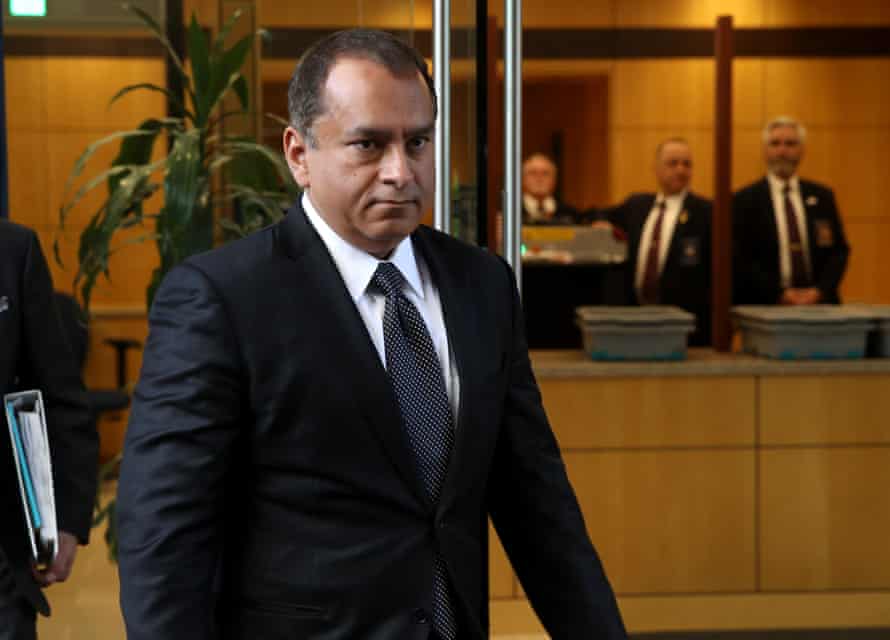Sackler family set to pay $4.5bn to settle opioid claims after judge approves plan
Conditional approval for plan to organize drugmaker into new company with board appointed by public officials
Wed 1 Sep 2021 22.33 BST
 The settlement sets up a compensation fund that will pay some victims of drug addiction an expected $3,500 to $48,000 each. Photograph: Douglas Healey/A
The settlement sets up a compensation fund that will pay some victims of drug addiction an expected $3,500 to $48,000 each. Photograph: Douglas Healey/AUnder the settlement reached with creditors including individual victims and thousands of state and local governments, the Sackler family will give up ownership of the company and contribute $4.5bn but will be freed from any future lawsuits over opioids.
The drugmaker will be reorganized into a new company with a board appointed by public officials and will funnel its profits into government-led efforts to prevent and treat opioid addiction.
Also, the settlement sets up a compensation fund that will pay some victims of drug addiction an expected $3,500 to $48,000 each.
US bankruptcy judge Robert Drain said on Wednesday he would approve the plan as long as two technical changes were made.
If so, he said, he will formally enter the decision on Thursday.
He said before his ruling that while he does not have “fondness for the Sacklers or sympathy for them”, collecting money from them through litigation would be complicated.
The settlement comes nearly two years after the Stamford, Connecticut-based company filed for bankruptcy under the weight of about 3,000 lawsuits from states, local governments, Native American tribes, hospitals, unions and other entities. They accuse Purdue Pharma of fueling the crisis by aggressively pushing sales of its bestselling prescription painkiller.
The Sacklers were not given immunity from criminal charges, though there have been no indications they will face any.
State and local governments came to support the plan overwhelmingly, though many did so grudgingly, as did groups representing those harmed by prescription opioids.
Nine states, Washington DC, Seattle and the US bankruptcy trustee, which seeks to protect the nation’s bankruptcy system, opposed the settlement, largely because of the protections granted to the Sackler family.
At least some of them were expected to appeal and the Washington state attorney general, Bob Ferguson, quickly announced he would appeal against the plan, calling it inadequate.
The bankruptcy judge, based in White Plains, New York, had urged the holdouts to negotiate an agreement, warning that drawn-out litigation would delay getting settlement money to victims and the programs needed to address the epidemic.
“Bitterness over the outcome of this case is completely understandable,” Drain said. “But one also has to look at the process and the issues and risks and rewards and alternatives of continued litigation versus the settlement laid out in the plan.”
He noted that the payout issue was mediated by Kenneth Feinberg, who oversaw the government’s September 11 Victim Compensation Fund.
Most states have sued Purdue, claiming it aggressively marketed OxyContin, contributing to an opioid overdose and addiction epidemic that has been linked to more than 500,000 deaths in the US.
Some of the deaths have been attributed to OxyContin and other prescription opioids, but most are from illicit forms of opioids such as heroin and illegally produced fentanyl. Opioid-linked deaths in the US continued at a record pace last year, hitting 70,000.
The crisis crushed the reputation of the Sackler family, major philanthropists whose name was once emblazoned on the walls of museums and universities around the world. With the settlement, family members who have owned the company will still be worth billions.
Whether the deal provides enough accountability for the Sacklers was the most contentious question through the proceedings. Many state attorneys general and advocacy groups working on behalf of opioid victims pushed for the family members to pay more and initially fought against the liability waiver.
They succeeded in boosting the amount the Sacklers would pay from a likely $3bn to a guaranteed $4.5bn over a decade.
David Sackler, a former Purdue board member, had testified that family members would not accept the agreement unless it protected them from lawsuits.
Otherwise, he said, the family would defend itself in litigation that could drag on for years, with the company’s and the family’s assets eaten up by lawyers’ fees rather than used to help address the crisis.
His father, Richard Sackler, a former Purdue president and board chairman, said under questioning that he, his family and the company did not bear responsibility for the opioid crisis.
Drain noted that none of the four Sacklers who testified offered an explicit apology. “A forced apology is not really an apology, so we will have to live without one,” he said.
The settlement also requires members of the Sackler family, who are scattered across the US, Britain and elsewhere in Europe, to get out of the opioid business worldwide.
Several attorneys general won another provision that will create a massive public repository of company documents, including communications with lawyers that normally would be protected by attorney-client privilege.
Purdue’s bankruptcy has been the highest-profile case in a complicated universe of opioid litigation.
Drugmaker Johnson & Johnson and the three largest US drug distribution companies recently announced a settlement that could be worth up to $26bn if state and local governments agree.
Individual trials also remain, including one scheduled to start in October in Cleveland over the role pharmacies played in the crisis. Other trials have been held this year in California, New York and West Virginia, though verdicts have not yet been reached.



